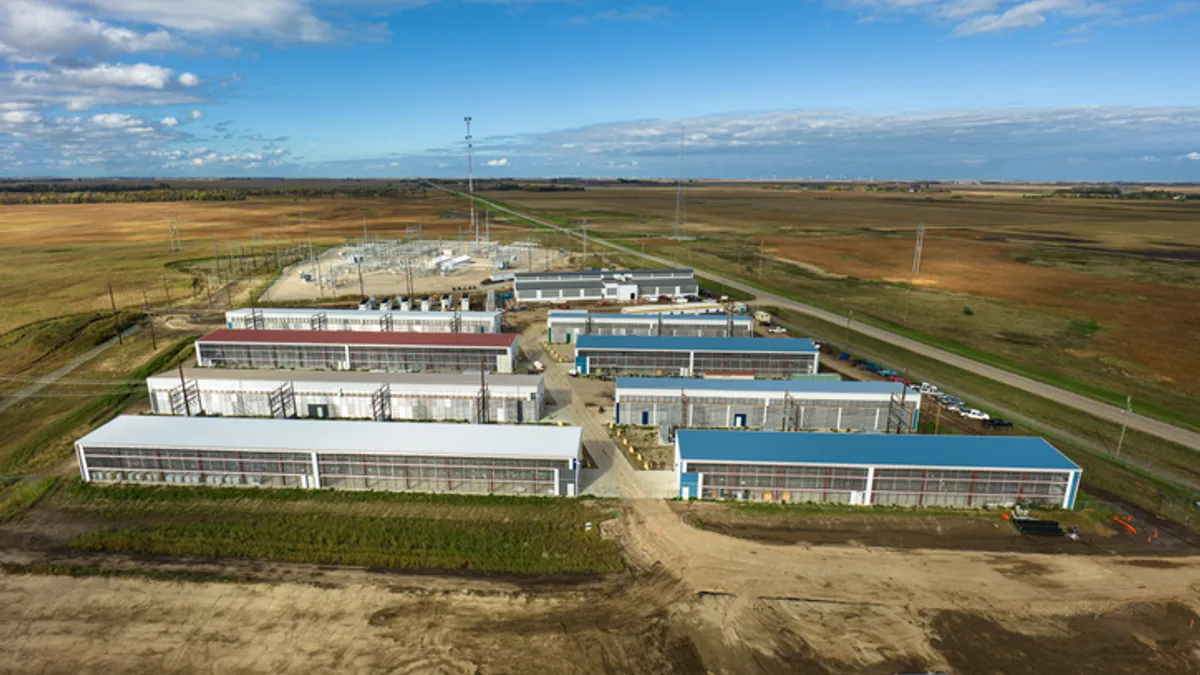Energy use by the Bitcoin network in the United States and globally could grow significantly in the next five years, adding many gigawatts of demand, according to some experts. With concerns increasing about utilities' carbon footprints, there is a growing push within the cryptocurrency industry to reimagine cryptomining systems as potential grid assets that can help balance demand and encourage renewable energy.
For those not up on cryptocurrencies, there are several, of which Bitcoin is the largest by market capitalization and energy use. "Mining" operations race to solve complex math problems, which allows them to validate new entries in a distributed ledger called a blockchain and, in turn, be rewarded with Bitcoin. The system is designed to make calculations increasingly difficult as demand for Bitcoin grows and the supply remains fixed. Solving the calculations requires growing amounts of energy consumed by large data farms.
Bitcoin mining operations now routinely participate in demand response programs, boosting their revenues by providing grid services. But critics say they are sometimes consuming fossil fuels that would otherwise go unused, and their potential as demand-side resources may be overstated.
Can Bitcoin be a grid asset? Or are the industry's claims a kind of crypto-greenwashing?
"It's complicated," said Eric Hittinger, interim chair of the Department of Public Policy at the Rochester Institute of Technology. "It's never quite clear to me where the line is between exaggeration and fabrication."
The electricity load used for crypto mining in the United States will reach almost 10,000 MW in the next five years, according to some estimates. Texas alone could see 5,000 MW of new demand by 2023, according to crypto miners in the state.
"There are going to be many, many gigawatts of additional incremental power demand in the United States" for Bitcoin on an ongoing basis, Digital Power Optimization CEO Andrew Webber said. The company offers "cryptocurrency mining as a service" and helps miners manage their energy use.
In the face of growing climate concern and potential regulation, miners say they have been consuming a cleaner mix of energy and working with utilities and grid operators to provide needed demand flexibility. The industry also touts its ability to spur the development of renewable energy, consume otherwise curtailed energy, and even help revitalize some of the country's aging hydropower assets.
At a recent congressional hearing on Bitcoin, lawmakers appeared open to blockchain innovations and their potential as a grid resource, while also raising concerns about the technology's energy consumption.
Blockchain technology has "numerous potential applications beyond cryptocurrency that will likely soon make our lives more efficient and secure," Rep. Diana DeGette, D-Colo., said at the Jan. 20 House Subcommittee on Oversight and Investigations hearing.
Bitcoin can provide grid flexibility and consume excess renewable generation, but there is often another side to the ledger involving increased electricity demand and carbon emissions, said Hittinger.
"I think crypto does provide some flexibility to electricity grids. It does introduce additional demand in, maybe, some of the right places," he said. However, "we could usually use that electricity for something that is maybe more socially valuable than mining crypto."
How much renewable energy does Bitcoin use?
The widely-cited Cambridge Bitcoin Electricity Consumption Index puts annualized global Bitcoin consumption at around 125 Twh and estimated demand at 14-15 GW. Those bullish on Bitcoin say energy demand could triple or quadruple in the coming years.
"From a public policy perspective, the most relevant question should be energy production rather than energy consumption," Brian Brooks, CEO of Bitfury Group, told the congressional subcommittee Jan. 20. He said Bitcoin mining in 2021 used about 58% sustainable energy, and was sourced from a cleaner energy mix than the bulk of U.S. electricity.
Regardless of that energy mix, DeGette noted examples in upstate New York and Pennsylvania where crypto mining operations are burning fossil fuels at power plants that might otherwise be closed. "Given our current climate objectives, examples like this are deeply concerning," she said.
The Greenidge power plant in Dresden, N.Y., is an example of how older power plants are being kept online to mine cryptocurrency and the environmental issues they raise. Private equity firm Atlas Holdings bought the defunct coal plant in 2014 and converted it to burn natural gas. It now primarily powers the company's Bitcoin operation, but the plant also sends energy back to the state's grid operator.
The Greenidge generation facility has a nameplate capacity rating of 112.5 MW and in 2020 injected 231.5 GWh of energy onto the bulk electric system, according to the New York Independent System Operator's 2021 Gold Book, which compiles load and capacity data. State regulators are currently reviewing its air permits.
More groups are focused on increasing the sustainability of the energy mix used for crypto.
Energy research nonprofit RMI is developing standards and solutions that can help cryptocurrency miners to decarbonize, said Marc Johnson, a senior associate in its climate intelligence program.
Through the Crypto Climate Accord, RMI is helping to provide guidance on how miners can "more comprehensively account for the emissions associated with their activities, and then providing some ways in which they can source the appropriate mitigation tools," Johnson said. Those mitigation methods potentially include renewable energy credits or other offsets.
The accord, inspired by the Paris Climate Agreement, has the support of more than 200 companies and individuals across the cryptocurrency, finance, technology, climate and energy sectors. Participants have committed to achieving net-zero emissions related to their crypto operations by 2030.
Other countries have similarly questioned the high energy needs of crypto mining. China banned Bitcoin mining in 2021 over concern for the stability of its financial institutions, prompting operations to move to other areas with cheap power, including Texas, New York and parts of the U.S. Southeast.
Cheap renewable generation in parts of the Southwest and Midwest could also attract crypto miners, say experts.
"These mining operations are enormous. They represent the single largest electricity loads in the world today," said Gregg Dixon, CEO of demand response provider Voltus.
Voltus is working with crypto miners to provide flexibility and services to grid operators. This month it announced plans to connect a 100-MW virtual power plant into the PJM Interconnection through a partnership with cryptocurrency miner Mawson Infrastructure Group.
Crypto benefits for curtailing activities through demand response
The ability of miners to rapidly modulate their operations makes them prime candidates for demand response participation, and that flexibility is worth millions of dollars, say Bitcoin experts.
Crypto miners can start, stop or pause computing processes, which allows for the addition of more flexible loads, Soluna Computing CEO John Belizaire told lawmakers at the congressional hearing. The company develops small-footprint data centers for cryptocurrency mining, helping ensure renewable generators can find a buyer for all of their output.
"This flexible load can help increase grid resilience," Belizaire said, likening computing power to "a better battery" that can help integrate more renewables onto the grid.
"Crypto mines are very different data center beasts," said Dixon, in that they can shut down "instantly." And that flexibility can be more valuable than the cryptocurrency being mined. Providing services back to the electric grid can generate anywhere from 2% to 10% of a mine’s revenue, he said.
Crypto miners are generally looking to pay between $0.03 and $0.04 per kWh, and they achieve that total cost of power by seeking out low-cost electricity and providing services back to the grid, said Dixon. Crypto miners typically curtail their usage from 100 to 500 hours per year in instances when “what they can make off of the grid is more than what they would make mining," he said.
But not all flexibility is the same, according to Hittinger. The cryptocurrency industry's demand response usefulness may be overstated. Crypto miners are happy to stop using energy when prices get high, he said, the same as any other factory. That's a good resource to have, but it only gets you so far.
"That helps us manage the grid when demand is really high," he said. "It doesn't help us use extra electricity when demand is low and supply is high." For that, something like an electric vehicle would be ideal: It consumes a certain amount of energy each day, but it's indifferent as to when it charges.
Crypto miners don't provide this flexibility because "if there was pretty cheap energy, they would just run 24/7," Hittinger said.
Texas leans on crypto for utilizing unused renewable capacity
While the demand response capabilities of Bitcoin may still be debated, the cryptocurrency industry is forging ahead, and grid operators appear to be on board.
Republican Sen. Ted Cruz has touted Bitcoin's potential to help stabilize the Texas grid and said crypto could be "a way to strengthen our energy infrastructure.” Crypto mining operations are helping grow the local economy and consume renewables that would otherwise be curtailed, according to the Electric Reliability Council of Texas (ERCOT), which operates most of the state's grid.
Crypto miners in West Texas "take advantage of negatively-priced electricity during times of low electric demand, and shut down when prices rise to a certain point," ERCOT said in a statement. "This supports their business, the Texas economy and uses a resource that would otherwise go unused."
"We have also seen crypto miners respond during grid events by rapidly reducing their electric use," the Texas grid operator continued. "During Winter Storm Uri, we saw them reduce their demand to zero which helped make power available to others during a grid emergency."
In practice, grid operators may not single out cryptocurrency miners as a particular segment, said Dixon, as they see the facilities as similar to any industrial resource. However, ERCOT said that as policy discussions around demand response continue, crypto "is a market segment that could play a larger role to quickly reduce demand when needed."
Reduced flaring, hydro revitalization and other benefits
Along with providing demand flexibility, the crypto mining industry can help bolster the grid and develop clean energy in a variety of others ways, crypto miners say, often by taking advantage of crypto mining wherever there is cheap energy and internet access.
Crypto miners can consume energy that would otherwise be curtailed, said Bitfury's Brooks, by locating near renewable generators and providing baseload consumption for solar and wind. They can also consume natural gas that would otherwise be flared at oil drilling operations "to turn that dead-weight loss into economic value," he said.
That same locational flexibility can help with transmission losses and distribution grid efficiency, he said.
"The mobility of Bitcoin mining allows the industry to construct data centers close to the power generation source, thus reducing these losses and turning the associated power into economic value while also reducing the need for additional investments in transmission and distribution infrastructure," Brooks said.
Digital Power Optimization's Webber said his company is also looking at how cryptocurrency mining can help revitalize the United States' aging hydroelectric infrastructure.
"There's a lot of defunct and underfunded hydroelectric assets around North America and elsewhere, frankly, that maybe haven't had their maintenance ... kept up to date," he said. "There's a lot of opportunity there to repair some of America's infrastructure."
"Crypto mining can actually revitalize disused, underused, underfunded energy assets that are 100 years old," he said. "And on top of that, whatever you're not using for your Bitcoin mine, you can then sell into the grid."























